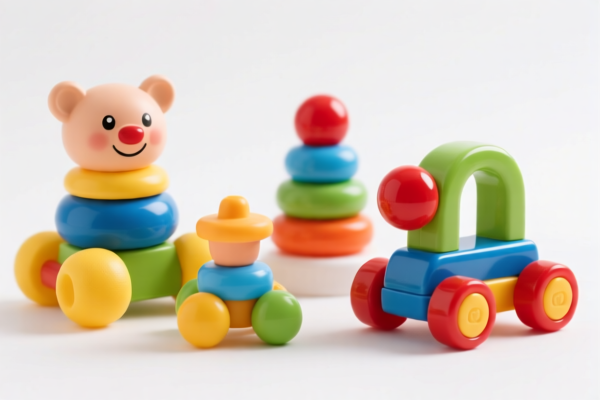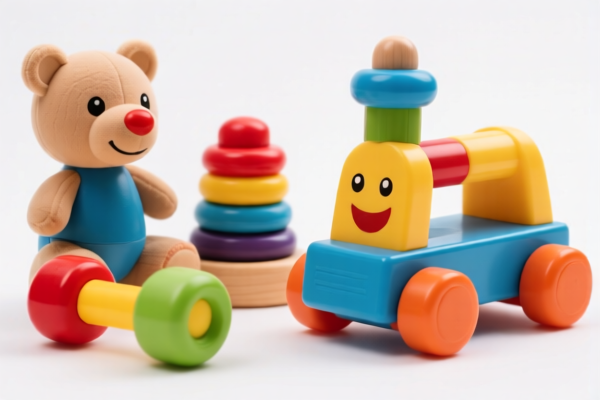| HS Code | Official Doc | Tariff Rate | Origin | Destination | Effective Date |
|---|---|---|---|---|---|
| 9503000071 | Doc | 30.0% | CN | US | 2025-05-12 |
| 9503000073 | Doc | 30.0% | CN | US | 2025-05-12 |
| 3213100000 | Doc | 6.5% on the entire set+55.0% | CN | US | 2025-05-12 |
| 3213900000 | Doc | 58.4% | CN | US | 2025-05-12 |
| 3210000000 | Doc | 56.8% | CN | US | 2025-05-12 |
| 4016992000 | Doc | 34.3% | CN | US | 2025-05-12 |
| 4008198000 | Doc | 58.3% | CN | US | 2025-05-12 |
| 4008294000 | Doc | 57.9% | CN | US | 2025-05-12 |
| 6913101000 | Doc | 37.5% | CN | US | 2025-05-12 |
| 6913905000 | Doc | 43.5% | CN | US | 2025-05-12 |
| 3924104000 | Doc | 33.4% | CN | US | 2025-05-12 |
| 3924905650 | Doc | 40.9% | CN | US | 2025-05-12 |




Painting Toys
Painting toys encompass a broad category of recreational items designed to be decorated by the user, typically with paints, but also including other coloring and embellishing materials. They serve as a creative outlet, fostering artistic expression and fine motor skill development.
Materials
The base materials for painting toys vary significantly:
- Wood: A common and readily available material, often used for figures, puzzles, and building blocks. Offers a good surface for paint adhesion.
- Plastic: Lightweight and durable, often molded into complex shapes. Requires specific types of paint formulated for plastic adhesion. Common plastics include PVC, polypropylene, and polystyrene.
- Ceramic/Bisque: Porcelain or unglazed ceramic is frequently used for figurines and ornaments, offering a smooth surface and ability to withstand high temperatures for firing (if glaze is used).
- Plaster: A relatively inexpensive material, often used for molds and casts. Can be porous and require sealing before painting.
- Paper Mache: Lightweight and easily shaped, often used for pinatas, masks, and decorative items. Requires sealing before painting to prevent paint absorption.
- Metal: Less common, but can be found in miniature figures or ornaments. Requires specific metal primers and paints.
Purpose & Function
The primary purpose of painting toys is to provide a platform for creative expression and artistic development. They function as:
- Educational Tools: Encouraging hand-eye coordination, color recognition, and imaginative thinking, especially in children.
- Hobby Materials: Providing a relaxing and engaging activity for individuals of all ages.
- Personalized Gifts: Allowing users to create unique and customized presents.
- Decorative Items: Finished painted toys can serve as ornaments, collectibles, or room décor.
Usage Scenarios
- Children’s Activities: School projects, playdates, birthday parties, and rainy-day entertainment.
- Arts & Crafts Workshops: Structured lessons and guided projects.
- DIY Projects: Creating personalized home décor or gifts.
- Model Building: Painting miniature figures for tabletop games or collectibles.
- Therapeutic Activities: Providing a calming and expressive outlet for individuals with disabilities or emotional needs.
Common Types
- Wooden Toys: Animals, vehicles, building blocks, puzzles, dolls, and nesting toys.
- Ceramic Figurines: Angels, animals, Christmas ornaments, gnomes, and decorative shapes.
- Plastic Model Kits: Cars, airplanes, dinosaurs, and fantasy creatures. These often require assembly before painting.
- Paint-Your-Own Pottery: Pre-made ceramic pieces available at pottery studios or for home painting.
- Rock Painting Kits: Smooth stones provided with paints and accessories for creating decorative rocks.
- Paintable Masks: Paper mache or plastic masks for decorating and wearing.
- Paintable Piggy Banks: Ceramic or plastic banks for personalization.
- DIY Dollhouses & Furniture: Miniature wooden or plastic structures and furnishings for painting and decorating.
- Paintable Garden Stones: Concrete or ceramic stones for outdoor decoration.
The declared goods, “painting toys,” can be classified under several HS codes based on their material, use, and intended age group. Here's a breakdown of potential classifications:
- 9503000071: This HS code covers tricycles, scooters, pedal cars and similar wheeled toys; dolls’ carriages; dolls, other toys; reduced-scale (“scaleˮ) models and similar recreational models, working or not; puzzles of all kinds; parts and accessories thereof, specifically categorized as “Children’s products” intended for use by persons under 3 years of age. If the painting toys are designed for this age group, this code applies. The total tax rate is 30.0%, comprising a 0.0% base tariff, a 0.0% additional tariff, and a 30.0% additional tariff effective April 2, 2025.
- 9503000073: This HS code also covers tricycles, scooters, pedal cars and similar wheeled toys; dolls’ carriages; dolls, other toys; reduced-scale (“scaleˮ) models and similar recreational models, working or not; puzzles of all kinds; parts and accessories thereof, but is for “Children’s products” intended for use by persons aged 3 to 12 years. If the painting toys are designed for this age group, this code applies. The total tax rate is 30.0%, comprising a 0.0% base tariff, a 0.0% additional tariff, and a 30.0% additional tariff effective April 2, 2025.
- 3924104000: This HS code covers tableware, kitchenware, other household articles and hygienic or toilet articles, of plastics, specifically categorized as tableware and kitchenware. If the painting toys are made of plastic and resemble tableware or kitchenware, this code may be applicable. The total tax rate is 33.4%, comprising a 3.4% base tariff and a 0.0% additional tariff, with a 30.0% additional tariff effective April 2, 2025.
- 3924905650: This HS code covers tableware, kitchenware, other household articles and hygienic or toilet articles, of plastics, categorized as “Other”. If the painting toys are made of plastic and do not fall under the tableware/kitchenware category, this code may be applicable. The total tax rate is 40.9%, comprising a 3.4% base tariff, a 7.5% additional tariff, and a 30.0% additional tariff effective April 2, 2025.
Important Note: The classification of “painting toys” heavily depends on the material composition and intended age group. If the toys are made of plastic, both 3924104000 and 3924905650 are potential options. If the toys are specifically designed for children under 3 or between 3-12 years, 9503000071 and 9503000073 are applicable.
Customer Reviews
No reviews yet.